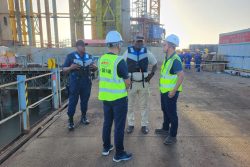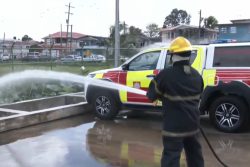ExxonMobil is forging ahead to meet its gas-to-shore pipeline completion target by the end of this year as the shut-down of two Floating Production, Storage and Offloading (FPSO) vessels in July to facilitate the pipe tie-in was completed and production offshore back to normal.
“We carried out shutdowns of the Liza Unity and Liza Destiny FPSOs to integrate pipelines essential for the gas-to-energy project, aligning with our work plans and forecasts for 2024. The Unity FPSO’s temporary halt began in early July and was concluded by mid-July, while the Destiny FPSO’s stoppage began in mid-July, finishing in early August,” ExxonMobil said in response to questions from Stabroek News.
“…Both FPSOs have resumed their normal operations and are running at full production levels,” the company explained. “The core purpose of the shutdowns was to install a GtE export riser on each FPSO, a process that involved laying deepwater pipelines and attaching them to the vessels.”
In May this year, President of ExxonMobil Guyana Alistair Routledge had explained that there would have been a shutdown as he informed that the pipeline laying aspect would be completed by the end of this year.
Then, he had also revealed that 70% of the pipeline’s offshore segment was completed. “So, the pipeline will be ready by the end of this year. In order to get it ready, we do need to take those shutdowns on Liza Phase One and Liza Phase Two. That will happen in the July/August timeframe, approximately two weeks for each of the shutdowns and those two FPSOs. They’ll be done separately… So, we’ll do one after the other. That will be one of the major steps to completing the pipeline. We’ll be ready by the end of the year,” Routledge had explained.
ExxonMobil also said that it maximized on the shut-down period as, “other maintenance, modifications, and reliability-related tasks were executed during this period.”
Routledge made it clear that his company was only responsible for bringing the gas to shore.
“What we are responsible for is executing the pipeline all the way from the connections we have talked about on the FPSO – the risers, the deep water pipeline all the way up unto the shallow shelf, crossing the seawall and then all the way down to Wales; the onshore pipeline. At that point it passes over to the government which is responsible for the integrated plant for the LNG [Liquid Natural Gas] extraction and the power generation and then the tie into the national grid,” Routledge said.
“All of that has to work for this project to ultimately deliver the low cost, lower emission, electricity everybody is looking for,” he added.
ExxonMobil’s GTE Project Manager Friedrich Krispin had told Stabroek News during an interview that after his company’s pipe laying component was completed, the pipes would be filled with nitrogen until the government’s completion of the integrated plant.
“We will not start-up bringing gas onshore until the plant is ready. The plant has a safety system that allows you to start up properly. We have to wait until the plant is ready. In the meantime, we will do what is called inerting the pipe, which is preserving the pipeline. You preserve a pipe by putting a gas that is inert that doesn’t combine with anything, doesn’t corrode with anything, etcetera,” Krispin had explained.
“So nitrogen will be inside the pipe. We fill it up with nitrogen and then we wait and whenever the plant is ready, we will release all of the nitrogen, which doesn’t cost anything to the atmosphere, then we start bringing in gas,” he added.








